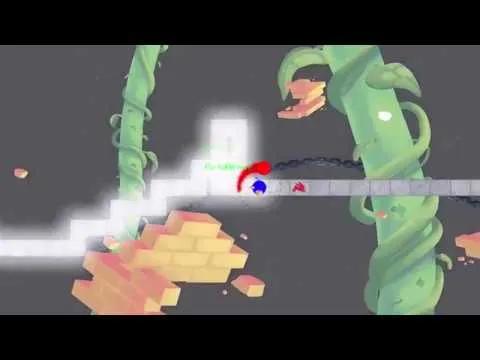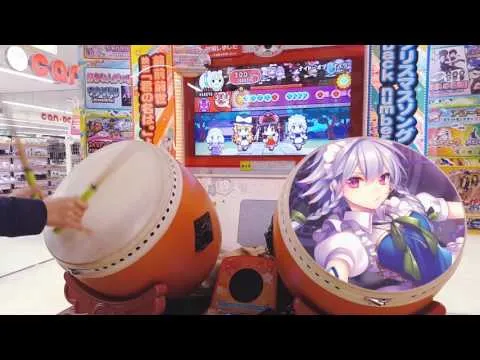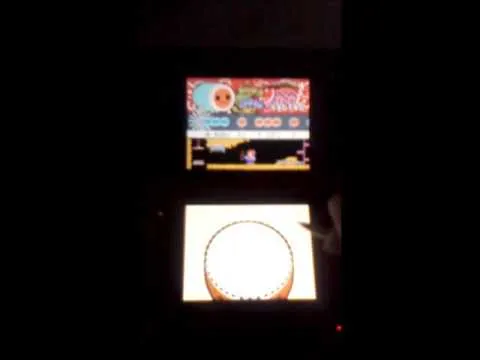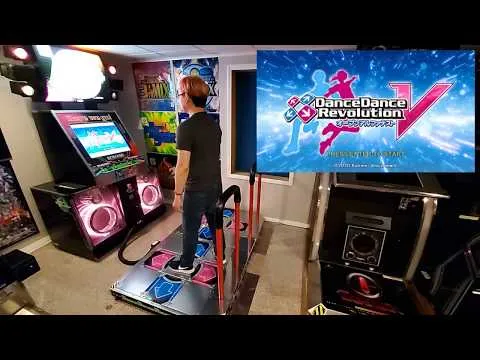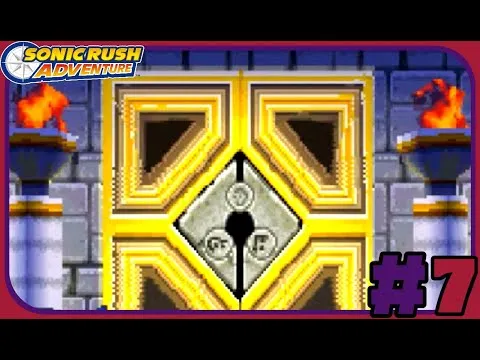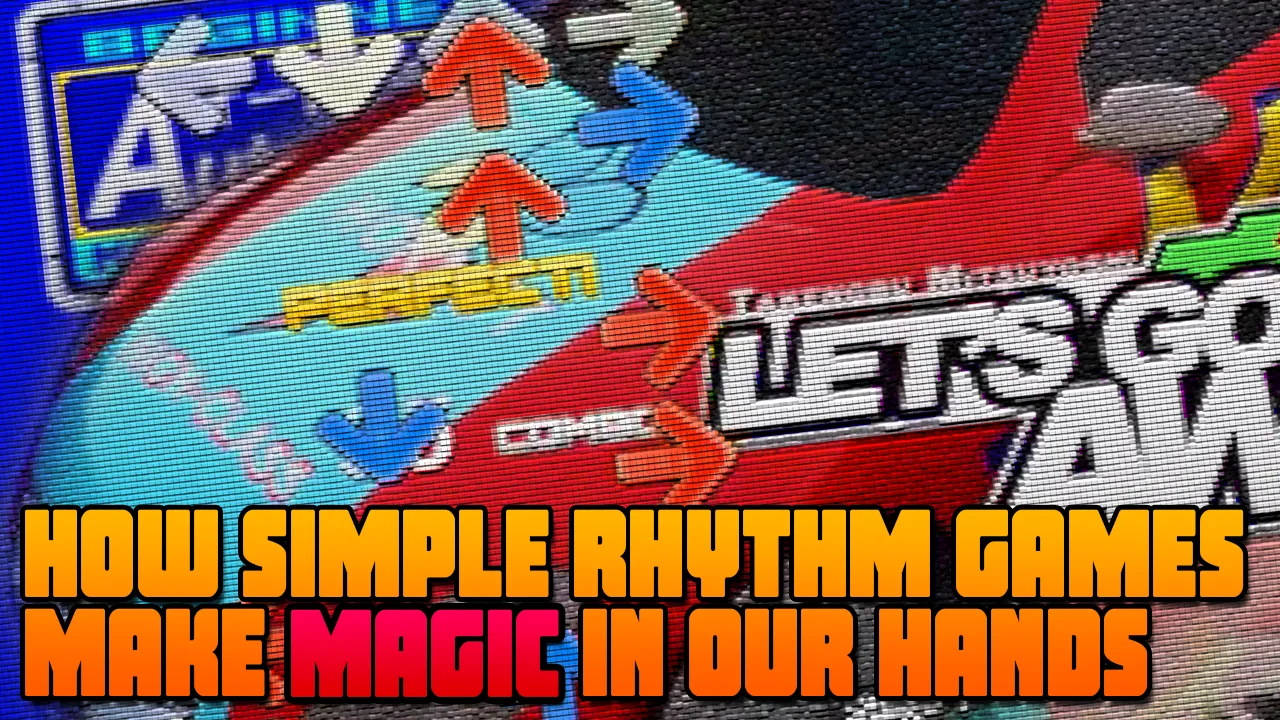

When rhythm games get mentioned, the first thoughts that could get to your head are very complex looking, very fast paced and virtually unreadable patterns to your mortal eyes played by unbelievably dexterous players, be in games like osu, beatmania, MaiMai, DDR, Guitar Hero- you get the point.
Now don't get it wrong: If these videos exist, that's because of how not only the skill ceiling is allowed to be raised that high for players that have dominated the best of the best, and also because there are players willing to push the game that far, akin to people that learn frame-perfect tricks in any% speedruns to finish a game in record time.
But what I want to focus is to chat a little about how some games can plausibly get to mold in anyone's hands with enough patience and creative incentive to follow the rhythm of the music while you push the buttons.
A Dance of Fire and Ice: Know where you're stepping
This is the game that inspired me to write this in the first place, as it is an ONE BUTTON rhythm game. You can use any keys, preferably two to cycle between two key presses instead of one, but the game only asks for any button to be pressed to the rhythm.
There's a free browser demo you can play that gets you up to the basics with a few short beats that exemplify some things, such as how the two circles going up or down a square instead of going straight would sound in the beat, and then you'll get a quick song that uses what you just got taught and now you have to keeo that rhythm steady until the end.
Learning how the song timing goes with trial and error is possible, but the examples you get before that provide a way to sorta sight read the path ahead if it is the first time trying...and a visual reference to remember what the rhythm of the tapping ahead was like.
I've seen some custom maps from the full game that really play with not only the visual effects for a stunning looking map, but also with the scrolling speed and readability with how the path can shift and reverse the circles visually so it is more about knowing well when and how to tap depending of the section of the song, as well as raw dexterity if the song forces you to tap insanely fast...but the concept alone and, assumingly, the base songs that could toy around with the visuals but not as much as custom maps, make for a very simple premise to understand as a rhythm game for a beginner.
Even if eventually, keeping up with the speeds it might require from you and having the memory to remember the patterns by hand if you still get confused with how they look, will demand more from you as a player. But that's just the usual rhythm game difficulty curve shtick, so don't feel disencouraged to try yourself, specially when how this game seems to follow a linear level structure rather than dropping you with a bunch of songs to choose.
And speaking of that...
Taiko no Tatsujin: Find your favorite and drum on
This one asks for two buttons for red and blue circles. You hit the red ones with the center of the drum and the blue ones with the rims of the drums...if you were playing on a drum controller in arcades or bought one for your home.
In any other controller or keyboard, you have two keys for red and two keys for blue, as when a big circle shows up, you need to press both of that color to get the best score from that press. So if you see a big red circle, then you hit both center/red keys, and same with the blue ones.
...And that's all the game technically asks you to do (there's also a few other things but that's the core of it). Everything else depends of the map you pick, as some can toy around with the rhythm or scrolling speeds, the difficulty which is shown with stars and is a good indicator to seek a challenge adequate to your level, and your overall performance.
Unlike other rhythm games, Taiko does not kick you out if you go under a certain threshold from missing notes (though if you play the Taiko mode in osu!, which is not part of the official games, it does)...but you do have to hit enough notes properly to reach the gold area of the meter, and you only get a Clear if the meter is there by the time the song ends. You can also tell if you're there when there's three or five characters on the little area for them to dance, and there's a crowd that appears bouncing there if you are at the maximum.
It might feel a bit harder to get on a standard controller, but if you can wrap your head around it, then its one of the most accessible rhythm games you can play and slowly raise the difficulty in your map choices until you're getting to the real difficult stuff with the hidden/unlockable Oni charts.
And if you have a DS or 3DS with a flashcart, you could also pop the DS games in there and try playing with the touchscreen, which is the closest to playing with the arcade drums if you can't afford one but do have a DS. The video below is super old and it was me trying to show off in that version with one hand, maybe recording with the other hand, but should illustrate how it could look on a DS.
Dance Dance Revolution: Step on the arrows...easy, right?
KevinDDR would like to have a word with you.
But seriously, while this has become more niche today between the slow extinction of arcades all over the world due to consoles and that fatidic 2020, some could tell you that back in the 90s and 2000s this was THE rhythm game people wanted to play. And if you stumbled upon one in arcades, its easy to tell why.
You also pick a song and go while keeping your health afloat, but the way the game's intended to play is super simple to understand, so once again the difficulty can come from faster songs with faster charts, or diving into the deadly swamp of Challenge charts that will actually force you to hold on that bar behind you in a cabinet to be able to tap with your feet as fast as those demand.
Once again, DDR does not just have to be about the most insane tapping feats on the world though, and the fact you could easily just dance around to the song freely while keeping an eye on the screen to tap when mandatory in easier charts (or if you are creative with the slightly harder ones) is what can allow you to go whatever way you want with the game.
Rhythm games that don't look like rhythm games?
There's two examples I can think of games that have pulled up a sneaky one to unsuspecting players, though these cases are very different from each other.
On one hand, you have the Patapon games, which aren't about timing your presses to a song...but embedding the rhythm of the chant your little Patapon army has to keep constantly to push towards a certain command, and you'll have to learn whenever to Pata-Pata-Pata-Pon or Pon-Pon-Pata-Pon or whatever else but always to the rhythm to not lose the combo and bonus it grants, in what mixes that little gimmick with something more akin to a strategy game.
And I still have to put my hands into it properly, but if you ask me about how effective this game was to get someone to gel with the rhythm based gameplay, then I have to bring up how one of my brothers who I never really saw play any rhythm games really had a good one playing through all three Patapon games.
On the other hand, there can always be some random game that has a rhythm-based minigame for some reason, and the first one I have memory of is Sonic Rush Adventure. Specifically, the last way of traversing through islands in the minimap is through a submarine minigame.
While the Waterbike and Hoverboat have you move Sonic through the water with the Stylus, and the Sailboat is like a light-gun game where you have to tap away anything that arrives, the Submarine has you tap and slide away enemies to the rhythm of the song that plays. And at least not only it is a cool way to do it with the music, but also is more interactive than a few other rhythm minigames in games might happen to be thanks to the stylus.
And that reminds me of Elite Beat Agents, which is an americanized version of the Japan-only "Osu Tatakae Ouendan" games for the DS...and these were the obvious inspiration for the osu! game everybody knows today, as you also have to tap the circles to the rhythm.
But the big difference and likely what made the original idea so appealing to turn into a full game is that with the DS touch screen, tapping and sliding the circles with the stylus feels so much more intuitive to do for anyone than having to get used to moving around the mouse, which is why I'd definitely recommend that one too for anyone that has a DS or 3DS.
And there's more?
Rhythm Heaven. If you know, you know. But if you don't, that one's all minigames with rhythm, comparable to Adofai but with more presentation variety due to the way its presented. And it is definitely one that you'll really get why it gets catchy if you can give it a look in action or play it.
There are over 1500 words right now...so at least for now, that's it for me with examples.
Okay, maybe except an honorable mention to Guitar Hero because the controller might be confusing for complete beginners but that is what makes it cool to play when you get used to it.
There are some rhythm games that can be quite overbearing with their usual charts, amount of buttons needed to press or just how much you need to move your fingers or hands to survive in tougher maps, and for complete beginners even the easier maps can be daunting to get used to for a while.
But these games I mentioned are what I mean when rhythm games don't always have to be Mozart on the Piano simulator, and some games that might only ask for a single button or two, use a specific input method to their advantage to be intuitive, or basically get their way to people through the way its presented, can definitely be enjoyed by complete beginners with enough time thanks to their entry-level controls.
Heya, was busy these past two days catching up to some university stuff, but it was nice to write this much once again as it was an idea that came up to my head after sticking my head for a bit in that ADOFAI demo...and you can tell that I had quite a bit to talk about, even when I did decide to stop myself from putting further examples when I noticed how much I had written already 😅
I hope that you enjoyed this new little exploration from the palace inside my brain of a handful of games I really used to play a lot before, and if you have a favorite rhythm game yourself, then let me know down below in the comments.
Thanks for reading!

Spanish translation with DeepL with manual corrections by me. All screenshots were captured by myself. Credits to all the creators of the videos linked in this post.
Español
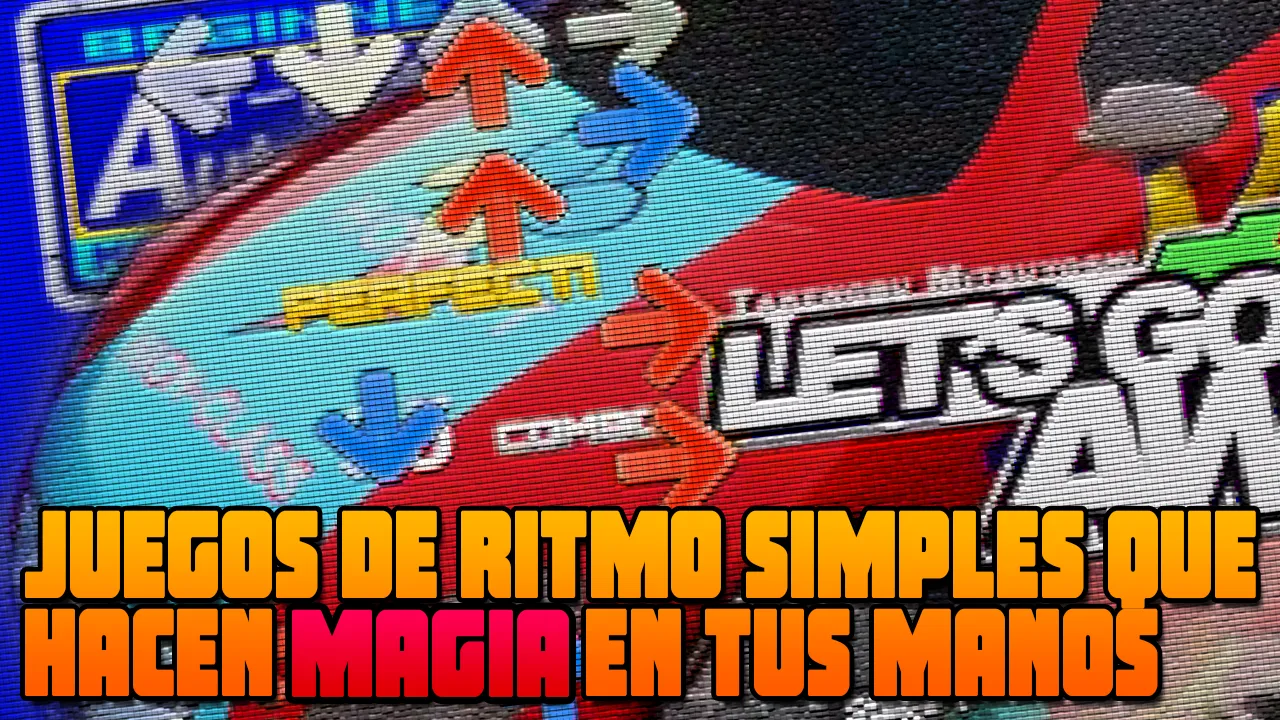
Cuando se mencionan los juegos rítmicos, lo primero que se te viene a la cabeza son patrones muy complejos, de ritmo muy rápido y prácticamente ilegibles para tus ojos mortales, ejecutados por jugadores increíblemente diestros, ya sea en juegos como Osu, Beatmania, MaiMai, DDR, Guitar Hero... ya me entiendes.
No lo malinterpretes: si estos vídeos existen, es porque no sólo se permite que el techo de habilidad se eleve tanto para los jugadores que han dominado a los mejores de los mejores, sino también porque hay jugadores dispuestos a llevar el juego tan lejos, como la gente que aprende trucos perfectos en cualquier speedrun para terminar un juego en un tiempo récord.
Pero en lo que quiero centrarme es en charlar un poco sobre cómo algunos juegos pueden llegar plausiblemente a moldearse en las manos de cualquiera con la suficiente paciencia e incentivo creativo para seguir el ritmo de la música mientras aprietas los botones.
A Dance of Fire and Ice: Mira por donde pisas
Este es el juego que me inspiró a escribir esto en primer lugar, ya que es un juego de ritmo de UN BOTÓN. Puedes usar cualquier tecla, preferiblemente dos para alternar entre dos pulsaciones de tecla en lugar de una, pero el juego sólo pide que se pulse cualquier botón al ritmo.
Hay una demo de navegador gratis que puedes jugar y te enseña lo básico con algunos ritmos cortos de ejemplos, como la forma en el que suena el ritmo si los dos círculos suben o bajan un cuadrado en lugar de ir en línea recta, y luego tendrás una canción rápida que utiliza lo que te acaban de enseñar y mantener ese ritmo constante hasta el final.
Aprender cómo va el ritmo de la canción con ensayo y error es posible, pero los ejemplos que obtienes antes de eso proporcionan una forma de leer a simple vista el camino a seguir si es la primera vez que lo intentas... y una referencia visual para recordar cómo era el ritmo del zapateado anterior.
He visto algunos mapas personalizados del juego completo que realmente juegan no sólo con los efectos visuales para un mapa de aspecto impresionante, sino también con la velocidad de desplazamiento y la legibilidad con la forma en que el camino puede cambiar e invertir los círculos visualmente por lo que es más acerca de saber bien cuándo y cómo golpear dependiendo de la sección de la canción, así como la destreza *raw * si [la canción te obliga a presionar increíblemente rápido](https://www. youtube.com/watch?v=0qbkoXwVJVc)... pero el concepto por sí solo y, suponiendo que las canciones base puedan jugar con los efectos visuales pero no tanto como los mapas personalizados, hacen que la premisa sea muy sencilla de entender como juego de ritmo para un principiante.
Aunque con el tiempo, mantener la velocidad que te pueda exigir y tener la memoria para recordar los patrones a mano si aún te confundes con su aspecto, te exigirá más como jugador. Pero esto no es más que la típica curva de dificultad de los juegos de ritmo, así que no te sientas desanimado para intentarlo, sobre todo cuando este juego parece seguir una estructura de niveles lineal en lugar de dejarte con un montón de canciones para elegir.
Y hablando de eso...
Taiko no Tatsujin: Encuentra tu favorita y tócale con el tambor
Este te pide dos botones para los círculos rojos y azules. Golpeas los rojos con el centro del tambor y los azules con los bordes de los tambores... si jugabas con un mando de tambor en los salones recreativos o te compraste uno para casa.
En cualquier otro mando o teclado, tienes dos teclas para el rojo y dos para el azul, ya que cuando aparece un círculo grande, tienes que pulsar las dos de ese color para obtener la mejor puntuación de esa pulsación. Así que si ves un gran círculo rojo, entonces pulsa las dos teclas centrales/rojas, y lo mismo con las azules.
...Y eso es todo lo que el juego técnicamente te pide que hagas (también hay algunas cosas más, pero eso es lo esencial). Todo lo demás depende del mapa que elijas, ya que algunos pueden jugar con el ritmo o las velocidades de desplazamiento, la dificultad que se muestra con estrellas y es un buen indicador para buscar un reto adecuado a tu nivel, y tu rendimiento general.
A diferencia de otros juegos de ritmo, Taiko no te echa si bajas de cierto umbral por notas perdidas (aunque si juegas al modo Taiko en osu!, que no forma parte de los juegos oficiales, sí lo hace)... pero sí tienes que tocar suficientes notas correctamente para llegar a la zona dorada del medidor, y sólo obtienes un Borrar si el medidor está ahí para cuando termina la canción. También puedes saber si estás ahí cuando hay tres o cinco personajes en la pequeña zona para que bailen, y hay una multitud que aparece rebotando ahí si estás al máximo.
Puede parecer un poco más difícil de pillar con un mando estándar, pero si consigues hacerte a la idea, es uno de los juegos de ritmo más accesibles que puedes jugar, y poco a poco va subiendo la dificultad en tus elecciones de mapa hasta que llegas a lo realmente difícil con las cartas Oni ocultas/desbloqueables.
Y si tienes una DS o 3DS con una R4, también puedes meter ahí los juegos de DS y probar a jugar con la pantalla táctil, que es lo más parecido a jugar con la batería arcade si no te puedes permitir una pero tienes una DS. El video de abajo es super viejo y era yo tratando de mostrar en esa versión con una mano, tal vez grabando con la otra mano, pero debe ilustrar cómo podría verse en una DS.
Dance Dance Revolution: Solo pisa las flechas...fácil, verdad?
A KevinDDR le gustaría hablar contigo.
Pero en serio, aunque hoy en día se ha convertido en un nicho más entre la lenta extinción de los salones recreativos en todo el mundo debido a las consolas y ese fatídico 2020, algunos podrían decirte que en los años 90 y 2000 este era EL juego de ritmo al que la gente quería jugar. Y si te topas con uno en los salones recreativos, es fácil saber por qué.
También eliges una canción y te lanzas mientras mantienes tu salud a flote, pero la forma en que está pensado el juego es súper sencilla de entender, así que una vez más la dificultad puede venir de canciones más rápidas con gráficos más rápidos, o sumergirte en el pantano mortal de los mapas Challenge que de hecho te obligarán a agarrarte a esa barra que hay detrás de ti en un mueble para poder golpear con los pies tan rápido como te piden.
Una vez más, DDR no sólo tiene que ser sobre las hazañas de pisar como metralleta más locas en el mundo, sin embargo, y el hecho de que fácilmente podría simplemente bailar alrededor de la canción libremente mientras se mantiene un ojo en la pantalla para golpear cuando sea obligatorio en los gráficos más fáciles (o si usted es creativo con los un poco más difícil) es lo que puede permitir que usted vaya lo que quieras con el juego.
¿Juegos de ritmo que no parecen juegos de ritmo?
Se me ocurren dos ejemplos de juegos que han engañado a jugadores desprevenidos, aunque son muy diferentes entre sí.
Por un lado, tienes los juegos de Patapon, que no van de cronometrar tus pulsaciones al ritmo de una canción... sino de incrustar el ritmo del cántico que tu pequeño ejército de Patapon tiene que mantener constantemente para empujar hacia un determinado comando, y tendrás que aprender siempre que sea a Pata-Pata-Pata-Pon o Pon-Pon-Pata-Pon o lo que sea pero siempre al ritmo para no perder el combo y el bonus que otorga, en lo que mezcla ese pequeño truco con algo más parecido a un juego de estrategia.
Y todavía tengo que meterle mano como es debido, pero si me preguntas por la efectividad de este juego para conseguir que alguien se encariñe con la jugabilidad basada en el ritmo, entonces tengo que sacar a colación cómo uno de mis hermanos al que nunca vi jugar a ningún juego de ritmo se lo pasó realmente bien jugando a los tres juegos de Patapon.
Por otro lado, siempre puede haber algún juego aleatorio que tenga un minijuego basado en el ritmo por alguna razón, y el primero del que tengo memoria es Sonic Rush Adventure. En concreto, la última forma de atravesar islas en el minimapa es a través de un minijuego de submarino.
Mientras que en Waterbike y Hoverboat tienes que mover a Sonic por el agua con el stylus, y el Sailboat es como un juego de pistola de luz en el que tienes que dar golpecitos para alejar a todo lo que llegue, en el Submarine tienes que dar golpecitos y deslizarte para alejar a los enemigos al ritmo de la canción que suena. Y por lo menos no sólo es una forma chula de hacerlo con la música, sino que además es más interactivo que otros minijuegos de ritmo en juegos que puede haber gracias al stylus.
Y eso me recuerda a Elite Beat Agents, que es una versión americanizada de los juegos japoneses "Osu Tatakae Ouendan" para la DS... y estos fueron la inspiración obvia para el juego osu! que todo el mundo conoce hoy en día, ya que también tienes que tocar los círculos al ritmo.
Pero la gran diferencia, y probablemente lo que hizo que la idea original fuera tan atractiva para convertirla en un juego completo, es que con la pantalla táctil de la DS, tocar y deslizar los círculos con el lápiz táctil resulta mucho más intuitivo para cualquiera que tener que acostumbrarse a moverse con el ratón, por lo que sin duda recomendaría ese juego también a cualquiera que tenga una DS o 3DS.
¿Y hay más?
Rhythm Heaven. Si lo conoces, lo conoces. Pero si no, ese es todo minijuegos con ritmo, comparable a Adofai pero con más variedad de presentación debido a la forma en que se presenta. Y sin duda es uno de los que realmente entenderás por qué engancha si puedes echarle un vistazo en acción o jugarlo.
Hay más de 1500 palabras en este momento ... así que al menos por ahora, eso es todo para mí con ejemplos.
Okay, quizás excepto una mención honorífica a Guitar Hero porque el mando puede resultar confuso para los principiantes, pero eso es lo que hace que sea genial jugar cuando te acostumbras a él.
Hay algunos juegos de ritmo que pueden resultar bastante agobiantes con sus gráficos habituales, la cantidad de botones que hay que pulsar o lo mucho que hay que mover los dedos o las manos para sobrevivir en los mapas más difíciles, y para los principiantes incluso los mapas más fáciles pueden resultar desalentadores para acostumbrarse durante un tiempo.
Pero estos juegos que he mencionado son lo que quiero decir cuando digo que los juegos de ritmo no tienen por qué ser siempre un simulador de Mozart al piano, y que algunos juegos que sólo necesitan uno o dos botones, que utilizan un método de entrada específico para ser intuitivos o que básicamente llegan a la gente por la forma en que se presentan, pueden ser disfrutados por principiantes con el tiempo suficiente gracias a sus controles básicos.
Heya, estaba ocupado estos dos últimos días ponerse al día con algunas cosas de la universidad, pero fue agradable para escribir esta cantidad una vez más, ya que era una idea que surgió en mi cabeza después de pegar la cabeza un poco en esa demo de ADOFAI y puedo decir que tenía unas cuantas cosas para hablar, incluso cuando me decidí a detenerme de poner más ejemplos cuando me di cuenta de lo mucho que había escrito ya 😅
Espero que hayáis disfrutado de esta nueva pequeña exploración desde el palacio interior de mi cerebro de un puñado de juegos a los que realmente solía jugar mucho antes, y si tú también tienes un juego de ritmo favorito, házmelo saber abajo en los comentarios.
¡Muchas gracias por leer!

Traducción al español hecha con DeepL y correciones manuales por mí. Todas las fotos capturadas por mí. Créditos a los creadores de los videos enlazados en este post.
